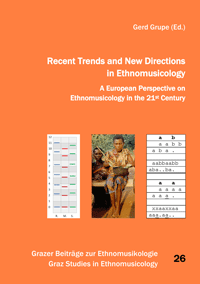
Shop : Details
Shop
Details
49,80 €ISBN 978-3-8440-7053-8Hardcover258 pages32 figures387 g24 x 17 cmEnglishConference proceeding
December 2019
Gerd Grupe (Ed.)
Recent Trends and New Directions in Ethnomusicology
A European Perspective on Ethnomusicology in the 21st Century
Based mostly on contributions to a lecture series hosted by the Institute of Ethnomusicology at the University of Music and Performing Arts Graz/Austria in 2018, this volume presents papers addressing Recent Trends and New Directions in Ethnomusicology from a European perspective. In order to do so an effort has been made to include authors from a wide range of European countries. In these papers major issues and topics shaping current ethnomusicological discourse are assessed. Thus, the topics covered in this volume include methodological considerations, insights into or from neighboring fields, various case studies, and more.
In “Potato Music Revisited and the Rise of a Worldly Music Studies: Perspectives from the UK” Henry Stobart presents a reassessment of the fundamental rejection of ethnomusicology as put forth by UK musicologist Harper-Scott. Ignazio Macchiarella, in his chapter on “Ethnomusicology as a Dialogue: Current Research in Sardinia”, by drawing on his own experiences during field research he carried out in Sardinia over many years, describes a dialogical approach as both an ethical requirement and a powerful tool for our investigations and studies. Sílvia Martínez’s piece “Mainstream Popular Music as a Challenge to Gender Studies: Latin Music and Feminism in Contemporary Spain” not only combines two issues highly topical in current ethnomusicology, i.e., gender and popular music. She also does so by investigating a kind of music, reggaeton, known for its particularly provocative and often openly offensive and sexist lyrics and visual representations. Catherine Foley, in her “Identity Matters: Irish Ethnochoreology and Ethnomusicology”, addresses a topic which has been characterized as the presumably most important function of music, i.e., identity, and vividly highlights the importance of dance in this context – a domain which very often has not received its due attention in ethnomusicological studies. Reaching out to neighboring fields and disciplines also characterizes the approach of Raymond Ammann and Michael Praxmarer. In their paper entitled “Cognitive Music Archaeology, a New Trend in Ethnomusicology: Interdisciplinary Research on Paleolithic Musical Instruments” they stress such collaboration beyond established boundaries. By employing current technological developments they seek to arrive at new insights into the prehistory of music-making tools.
Can anything be gained from musical analysis at all and, if yes, how can we achieve a culturally informed one? In the present volume three contributions can be said to aim at contributing to this general endeavor. Susanne Fürniss, in “Anthropological and Historical Resources of Music Analysis”, looks at several music traditions in Central Africa and contextualizes their investigation in relation to the emergence of a “French school of African[ist] ethnomusicology”. Based on long-term field studies, emic views complementing our scholarly interpretations of what we have observed, lead to a better understanding of underlying concepts and actual practices. In his paper on “The Significance of Interactive Analysis in Understanding the Emic Perception of Musical Structures: The Case of South Iranian Bagpipe Music”, which is also based on extensive fieldwork, Babak Nikzat outlines local concepts about tunings and scales among musicians in southern Iran. Since these models mostly have to be derived from the musicians’ tacit knowledge specific research strategies need to be applied. The volume closes with an account of a case study which Gerd Grupe conducted on Central Javanese gamelan music. “Music aesthetics, idiomatic performance practice, dialogue, and two modes of discourse” all come into play here, thus to some extent tying in with issues addressed in earlier chapters. The paper traces potential ways of elucidating aesthetic concepts and preferences of gamelan musicians in a dialogic fashion incorporating computer-based research methods.
In “Potato Music Revisited and the Rise of a Worldly Music Studies: Perspectives from the UK” Henry Stobart presents a reassessment of the fundamental rejection of ethnomusicology as put forth by UK musicologist Harper-Scott. Ignazio Macchiarella, in his chapter on “Ethnomusicology as a Dialogue: Current Research in Sardinia”, by drawing on his own experiences during field research he carried out in Sardinia over many years, describes a dialogical approach as both an ethical requirement and a powerful tool for our investigations and studies. Sílvia Martínez’s piece “Mainstream Popular Music as a Challenge to Gender Studies: Latin Music and Feminism in Contemporary Spain” not only combines two issues highly topical in current ethnomusicology, i.e., gender and popular music. She also does so by investigating a kind of music, reggaeton, known for its particularly provocative and often openly offensive and sexist lyrics and visual representations. Catherine Foley, in her “Identity Matters: Irish Ethnochoreology and Ethnomusicology”, addresses a topic which has been characterized as the presumably most important function of music, i.e., identity, and vividly highlights the importance of dance in this context – a domain which very often has not received its due attention in ethnomusicological studies. Reaching out to neighboring fields and disciplines also characterizes the approach of Raymond Ammann and Michael Praxmarer. In their paper entitled “Cognitive Music Archaeology, a New Trend in Ethnomusicology: Interdisciplinary Research on Paleolithic Musical Instruments” they stress such collaboration beyond established boundaries. By employing current technological developments they seek to arrive at new insights into the prehistory of music-making tools.
Can anything be gained from musical analysis at all and, if yes, how can we achieve a culturally informed one? In the present volume three contributions can be said to aim at contributing to this general endeavor. Susanne Fürniss, in “Anthropological and Historical Resources of Music Analysis”, looks at several music traditions in Central Africa and contextualizes their investigation in relation to the emergence of a “French school of African[ist] ethnomusicology”. Based on long-term field studies, emic views complementing our scholarly interpretations of what we have observed, lead to a better understanding of underlying concepts and actual practices. In his paper on “The Significance of Interactive Analysis in Understanding the Emic Perception of Musical Structures: The Case of South Iranian Bagpipe Music”, which is also based on extensive fieldwork, Babak Nikzat outlines local concepts about tunings and scales among musicians in southern Iran. Since these models mostly have to be derived from the musicians’ tacit knowledge specific research strategies need to be applied. The volume closes with an account of a case study which Gerd Grupe conducted on Central Javanese gamelan music. “Music aesthetics, idiomatic performance practice, dialogue, and two modes of discourse” all come into play here, thus to some extent tying in with issues addressed in earlier chapters. The paper traces potential ways of elucidating aesthetic concepts and preferences of gamelan musicians in a dialogic fashion incorporating computer-based research methods.
Keywords: Ethnomusicology; Graz; Music
Grazer Beiträge zur Ethnomusikologie/Graz Studies in Ethnomusicology
Edited by Univ.Prof. Dr.phil. Sarah Weiss and Dr.phil. Assoc. Prof. Kendra Stepputat, Graz
Volume 26
Available online documents for this title
You need Adobe Reader, to view these files. Here you will find a little help and information for downloading the PDF files.
Please note that the online documents cannot be printed or edited.
Please also see further information at: Help and Information.
Please also see further information at: Help and Information.
| Document |  | Document | ||
| Type |  | |||
| Costs |  | 37,35 € | ||
| Action |  | Purchase in obligation and download the file | ||
| Document |  | Table of contents | ||
| Type |  | |||
| Costs |  | free | ||
| Action |  | Download the file | ||
User settings for registered online customers (online documents)
You can change your address details here and access documents you have already ordered.
User
Not logged in
Export of bibliographic data
Shaker Verlag GmbH
Am Langen Graben 15a
52353 Düren
Germany
Am Langen Graben 15a
52353 Düren
Germany
Mon. - Thurs. 8:00 a.m. to 4:00 p.m.
Fri. 8:00 a.m. to 3:00 p.m.
Fri. 8:00 a.m. to 3:00 p.m.
Contact us. We will be happy to help you.



